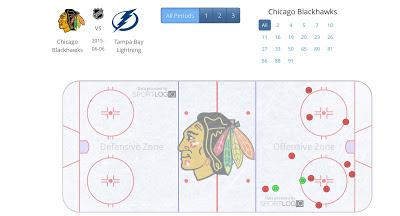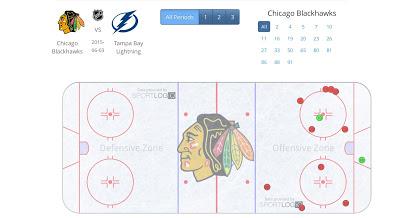Any scoring-chance starts with a team gaining possession of the puck in the offensive-zone. This can be done off of a face-off, a dump-in, or by way of a controlled entry. Seven of Chicago's 14 scoring-chances have come off of controlled entries, 3 have come off of a dump-in followed by a loose-puck recovery, while 4 others have been produced off of offensive-zone face-offs.
The next step in producing a scoring-chance requires a team to get the puck to a player positioned in the slot. Generally, this can be achieved one of four ways; a player can pass to a teammate positioned in the slot, a player can skate the puck into the slot, a player can recover a loose-puck produced from a rebound, or a player can recover a loose-puck positioned in the slot following a successful forechecking play.
Among the Blackhawks scoring-chances in this series, 57.1% have been produced by a player skating the puck into the slot, 14.3% have come off of rebounds produced following a shot through from outside the slot, 21.4% have occurred following a successful pass to the slot, while 7.1% have come off a loose-puck recovery produced from a successful forechecking event.
The first step to producing a scoring-chance from a rebound is to get a shot through to the net. With this in mind, producing scoring-chances off of rebounds has been challenging for the Blackhawks, as they have only been able to get 37.3% of their shots originating from outside the slot through to the net. The average in NHL games tracked this season was 46.6%.
Despite the fact that 21.4% of the Hawks scoring-chances have been produced by a successful pass to the slot, Chicago has actually only completed 4 of the 24 passes-to-the-slot they have attempted; with 2 of the 4 successful passes coming from the stick of Patrick Kane. This team success-rate of only 16.7% is well below the league-wide regular season average of 31.4% in games tracked.
Position-wise, Chicago has attempted only 1 of their 24 attempted passes to the slot from below Tampa Bay's goal-line, seven others have come from a player already positioned in the slot, while 9 have come from players positioned on the half-wall.
CHIGAGO PASSES TO THE SLOT GAME 2 (green=successful/red=failed)

CHICAGO PASSES TO THE SLOT GAME 1 (green=successful/red=failed)

Looking at Lightning games scouted during these playoffs, teams have been successful with 22.2% of their attempted passes to the slot coming from the half-wall, and 21.4% from below the goal-line. The Rangers in fact, had one game where they produced 20 ES scoring-chances against Tampa. This scoring-chance total was a product of a 5 for 12 (41.7%) success-rate when attempting a pass to the slot from below the Lightning's goal-line.
If Chicago hopes to produce more scoring-chances at even-strength, they must work on improving their numbers when attempting to get the puck to players positioned in the slot. This work starts with getting more shots through to a rebound-producing Ben Bishop, and continues with attempting more passes to the slot from below the Lightning's goal-line.
